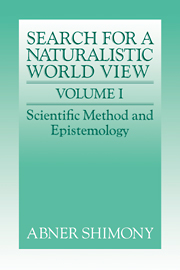Book contents
- Frontmatter
- Contents
- Acknowledgments
- A THE DIALECTIC OF SUBJECT AND OBJECT
- B PERCEPTION AND CONCEPTION
- C EPISTEMIC PROBABILITY
- D INDUCTIVE INFERENCE: THE DIALECTIC OF EXPERIENCE AND REASON
- 9 Scientific inference
- 10 Reconsiderations on inductive inference
- 11 Comments on two epistemological theses of Thomas Kuhn
- E FACT AND VALUE
- Index
10 - Reconsiderations on inductive inference
Published online by Cambridge University Press: 21 December 2009
- Frontmatter
- Contents
- Acknowledgments
- A THE DIALECTIC OF SUBJECT AND OBJECT
- B PERCEPTION AND CONCEPTION
- C EPISTEMIC PROBABILITY
- D INDUCTIVE INFERENCE: THE DIALECTIC OF EXPERIENCE AND REASON
- 9 Scientific inference
- 10 Reconsiderations on inductive inference
- 11 Comments on two epistemological theses of Thomas Kuhn
- E FACT AND VALUE
- Index
Summary
BAYESIAN GENERALITIES ON INDUCTIVE INFERENCE
My most systematic discussion of inductive inference was “Scientific Inference,” published in 1970. The title indicates its primary concern with reasoning in the sciences, though many of its considerations also apply elsewhere. I aimed at articulating principles of inductive reasoning actually used by working scientists, sometimes explicitly and sometimes tacitly. And I proposed justifications of these principles, in spite of the powerful tradition from Hume onward that this exercise is futile. Of course, the proposals for justification had to be made in tandem with a dialectical examination of the criteria that “justification” should satisfy.
My proposals fell under the denomination of “Bayesian,” with some reservations. The central concept of inductive inference was taken to be epistemic probability: a quantitative measure of reasonable degree of belief in a hypothesis on specified evidence. The standard epistemic probability notation “P(h/e) = r” is to be read, “the reasonable degree of belief in h, given e as the total body of evidence, is (the real number) r.” This rough explication is vague, for the constraints on “reasonable” are not specified, and indeed the lines of cleavage of Bayesianism are largely determined by different specifications of these constraints. But all the Bayesians agree (in contrast with frequency theorists of probability and with statisticians of the schools of Fisher and Neyman-Pearson) that the domain of pairs of propositions over which the function P is well defined is very wide, permitting one inter alia to speak of the “prior probability” of a hypothesis h, the evidential proposition e being taken to be a tautology t or possibly the general background information b.
- Type
- Chapter
- Information
- The Search for a Naturalistic World View , pp. 274 - 300Publisher: Cambridge University PressPrint publication year: 1993
- 2
- Cited by



